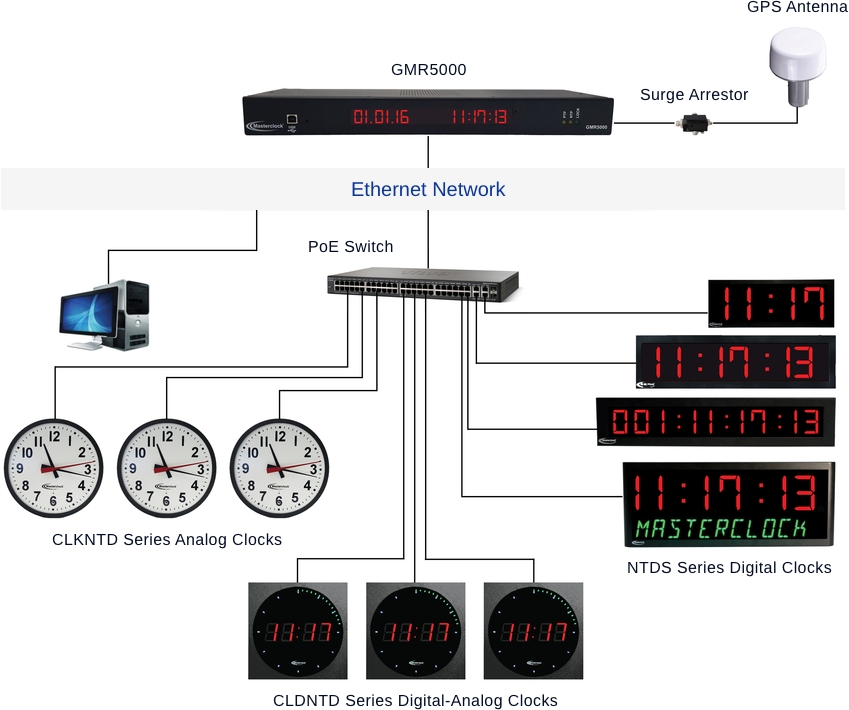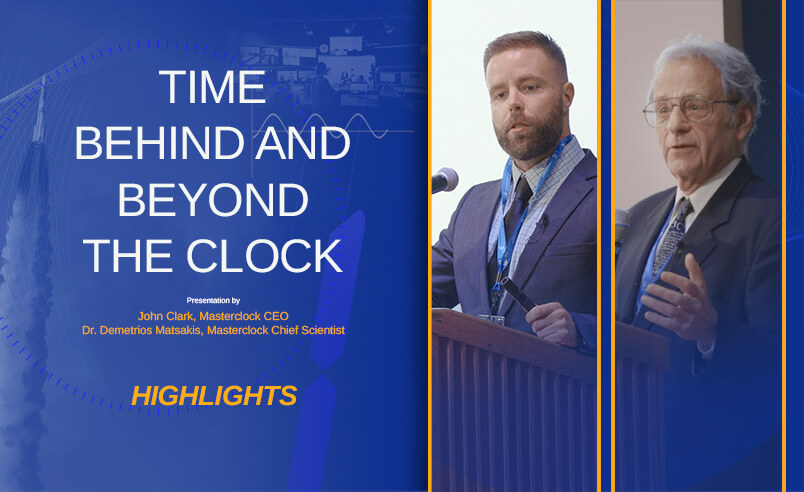Whether you're trying to get people to show up for a meeting or managing a scalable cloud-based business application, synchronicity is vital. Countless stakeholders and machines play essential roles in your processes. Keeping them all on the same timetable lets your organization move forward as a cohesive unit.
As far as networked hardware is concerned, you can't afford timing disparities. Here's how network time synchronization works and how to make your practices more effective.
Network Time Synchronization Explained: A Brief Intro to Timing Protocols
There are many ways to ensure that your servers, security systems, media recorders and other devices are operating in sync. Fortunately, you don't have to resort to manually setting clocks or cobbling together your own timing tools and shell scripts.
The existence of widely accepted protocols makes it possible to deploy a compliant system and rest assured of its ability to track time as expected. To get started, let's take a quick look at two of the most common timekeeping systems: Network Time Protocol and Precision Time Protocol.

Network Time Protocol
The NTP standard employs servers that supply clients, such as the computers in your network, with current Coordinated Universal Time, or UTC, information in response to individual requests. Although your hardware can ask for the present time from many different servers in the network, some devices provide more accurate data than others due to factors like system lag and latency.
The timekeeping servers in these networks are arranged in distinct strata, also known as layers. The most accurate devices exist in Stratum 0, and they include atomic, radio and other high-precision clocks, such as those found in NIST laboratories and GPS satellites. Stratum 1 servers, also known as primary time servers, are connected directly to Stratum 0 devices as well as their same-level peers.
This protocol also:
- Lets clients connect to multiple NTP servers for data backups, heightened accuracy and testing purposes
- Corrects for communication latency and individual clock drift
- Uses a standardized, 64-bit UDP packet that can theoretically achieve picosecond (trillionth of a second) timing and determine dates within a 136-year range
- Permits peer-to-peer communication, broadcasting, multicasting, calibration and secure MD5 hash algorithms
Another variant of this protocol, known as SNTP or Simple Network Time Protocol, employs the same packet and message format. The major difference is that SNTP is significantly less accurate. Since clients cannot obtain timing data from multiple sources or use MD5 checksums, they're vulnerable to general network inaccuracies and malicious agents that intentionally provide incorrect time stamps.
Precision Time Protocol
PTP, defined in IEEE 1588, facilitates applications where the NTP lacks sufficient accuracy. By utilizing hardware-based timestamping, it provides more accurate synchronization.
Instead of clients requesting timing information, master clocks initiate contact by sending them data that they can use to stay in sync. As a PTP grandmaster communicates with the clocks it's synchronizing, the information passing from one machine to the other gains a timestamp at each stop.
Why is time stamping important? These sequential records serve as references that can help quantify how much network latency exists between a grandmaster and a given slave clock. Such features give IEEE 1588-compliant devices the ability to:
- Make up for latency introduced by local network conditions and correct timestamps to account for such delays
- Use an algorithm called best master clock, or BMC, to choose the fittest clock source from a range of candidates
- Reliably track time down to the nanosecond, or billionth of a second, and picosecond levels
- Enable varied network topographies, such as all of the slave clocks connecting to a single grand master timing reference or the grandmaster sending timing data to boundary clocks that then synchronize other slaves
Why the Global Positioning System & Time Synchronization Go Hand in Hand
By using dedicated hardware devices, PTP networks gain the power to minimize latency that could arise as a result of unforeseen factors. For instance, timekeeping software routinely has to contend with challenges like a lack of local operating system resources and unquantifiable delays in network communications.
There are numerous ways to overcome such hurdles. One widely accepted technique uses synchronization references that include highly-accurate GPS satellites.
The Global Positioning System
The Global Positioning System, commonly known as GPS, does more than just let consumers find their way around during vacation road trips. This system consists of fixed constellations of special orbiting satellites that each carry:
- Stabilized Stratum 0 atomic clock hardware
- Advanced location tracking circuitry
- Transmitters that constantly broadcast their position and clock time
These satellites are all synchronized to the same time and have known locations due to their geosynchronous orbits. As a result, receivers can listen to multiple broadcast sources and use trilateration, which is somewhat similar to triangulation, to determine their own position and time deviation.
Making Up for Lost Time
Although the Global Positioning System is very accurate, it's not without problems. The satellite network employs its own time standard, and this doesn't quite match up with what we use here on Earth.
The speed at which our planet rotates varies. This phenomenon is due to factors like:
- Massive sea currents causing tidal acceleration that slows down our world's rotation and gradually lengthens its days
- The movement of the fluid metallic core inside the Earth
- Changing atmospheric currents
To deal with these factors, Coordinated Universal Time introduces a leap second that gets tacked on to the time to keep it precisely locked with atomic time. However, unlike the highly predictable leap year, these extra seconds are added as needed to ensure that UTC and mean solar time, or UT1, never differ by more than 0.9 seconds.
GPS doesn't accommodate these extra seconds, so it's still tied to the way UTC was in 1980. As a result, satellites must broadcast additional offset information to let receivers know how much they need to adjust their estimates.
Real-World Implementations
What should users look for in GPS NTP Server Hardware?
Different network timekeeping options all have their pros and cons. While accuracy is definitely a positive, it may be prohibitively expensive to equip every one of your networked machines with a direct link to a Stratum 1 source. Or you might find that your system control application places a greater value on local synchronization than it does on matching external UTC sources.
How can you identify a timing solution that serves your purposes? Dedicated GPS NTP servers offer numerous advantages.
Legally Traceable Time
Traceability describes how the results of your time estimation relate to a specific reference. In the world of network timekeeping, for instance, you can build a chain of traceability that links your timing measurements to their sources. You can then use the chain to satisfy legal requirements.
For instance, you might provide stakeholders and users with accurate estimates of your measurements' total ambiguity by adding the uncertainties of the individual sources you utilized to calculate them. Such precision is vital when timing is required for critical applications, such as:/p>
- Financial transactions
- Manufacturing control
- Network operation
- Commercial ventures
- Video surveillance
Network time servers that provide traceable time place you on firmer legal footing. By allowing you to offer an extra degree of precision in the form of uncertainty measurements, traceable time estimates help you avoid being deemed liable for losses caused by unavoidable inaccuracies.
Widespread Standards Compliance
The most effective servers don't only use NTP. They're also conversant with PTP and other standards. This means that you can integrate them seamlessly into a range of network configurations.
Such flexibility also extends to the clock source side of the timekeeping architecture. Servers can use other geosynchronous satellite constellations, such as the Russian GLONASS system, in addition to the U.S. Global Positioning System for legally traceable time. This practice is advantageous because systems that employ a greater number of data points can produce quicker, more precise time and positioning estimates. They can also accept various synchronizing signals over Ethernet, so it's possible to create a customized implementation that serves your purposes and satisfies your budget constraints.
Which kinds of features should you look for? Keep an eye out for perks like:
- NTP and IEEE 1588 PTP client and server functionality
- GPS or GNSS reference
- MD5 hash authentication
- SSH for secure communication
- IPv6 compatibility
Functional Features & Form Factor
As more enterprise, nonprofit, and consumer computing operations shift to the cloud and other unique network architectures, the hardware they use has to evolve as well. Even if you're deploying your timing equipment indoors, the value of ruggedness can't be overstated.
For instance, are you confident that your servers will be able to withstand the humidity in a hot automated warehouse if an air handler breaks in the middle of summer? What if your data center's infrastructure management systems fail? Your devices should be rated for a reasonably wide range of environmental and power supply conditions to ensure that unexpected fluctuations don't cause gaps in your operational continuity.
Also, remember that robustness isn't only physical. Reliable time servers can function properly even in the absence of satellite connections. In the event of signal loss, they use high-accuracy internal oscillators to keep counting the passage of fractional seconds. Since manufacturers calibrate these devices with great precision if a server loses source lock, the oscillator can compensate for any drift until signals from GPS satellites or other sources are regained.
Other features make it easier to build unique networks that do more than just keep track of time. For instance, some servers feature programmable relays that you can use to toggle circuit switches according to a custom daily schedule.
Implement Superior Network Timekeeping Today
You have many options for instituting effective network time synchronization, but the one thing that you can't afford is to forego it altogether. Although it's only natural to think about considerations like hardware cost, investing in timekeeping servers saves you money in the long run by:
- Minimizing your organizational liability
- Making it easier to maintain synchronicity
- Operating more precisely
- Providing your clients with heightened service accuracy
Choosing a network timekeeping server may not be your only concern when building a network, but it's definitely one of the most important. Whether you rely on IEEE 1588 or decide to stick with legally traceable time NTP implementations, your server needs to offer proven reliability, robustness, and flexibility that can drive your operations forward.
Ready to learn more about GPS NTP and PTP server options and deployment strategies? Talk to a Masterclock specialist today. With devices like the NTP100-GPS, GMR1000 and GMR5000 in your network, it's never been simpler to ensure that your mission-critical operations are always on time.
Return to Knowledge Center to learn more.

